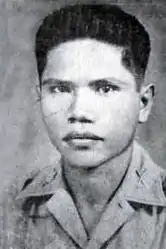Juan Pajota | |
|---|---|
 Captain Juan Pajota in 1945 | |
| Born | c. 1914 Nueva Ecija, Insular Government of the Philippine Islands, United States |
| Died | December 20, 1976 (aged 61–62) Chicago, Illinois, U.S. |
| Allegiance | |
| Service/ | USAFFE 45th Infantry Regiment Philippine Scouts[1][2] ,91st Div PA |
| Years of service | 1941–1946 |
| Rank | |
| Battles/wars | World War II
|
| Awards | Bronze Star |
| Spouse(s) | Juliana Francisco[3] |
Captain Juan Pajota (c. 1914 – December 20, 1976) was involved in the Raid at Cabanatuan, an action which took place in the Philippines on 30 January 1945 by US Army Rangers and Filipino guerrillas and resulted in the liberation of more than 511 American prisoners of war (POWs) from a Japanese POW camp near Cabanatuan.[4]
World War II
He was trained in the 45th Inf. Philippine Scouts, with the rank of Lieutenant, assigned as an Instructor to the 91st Div. 92nd Inf., Philippine Army in May 1941. The 91st Div. 92nd Inf. was established on Samar and on Sept 12, 1941 they were transferred to Luzon and their training camp was near Cabanatuan. About Dec. 20th they were ordered to assist the 26th Cavalry Philippine Scouts in Pampanga province and engaged in combat until the retreat to Bataan near the end of Dec. During the retreat he and some others of the 91st were cut off by the Japanese and delayed getting into Bataan in January where they found their former training camp had been taken over by the Japanese. He and another member of the 45th Inf. Philippine Scouts, Maj. Robert Lapham, formed a guerrilla unit on the Luzon Central Plains, and Juan became a leader of this unit and promoted to captain. This unit included the remnant of the 91st who were with him and new recruits.
Raid at Cabanatuan
The Raid at Cabanatuan was a rescue of Allied prisoners of war (POWs) and civilians from a Japanese camp near Cabanatuan, Philippines. On January 30, 1945, during World War II, United States Army Rangers, Alamo Scouts, and Filipino guerrillas liberated more than 511 from the POW camp.[5]
Under the command of Captain (later promoted Major) Juan Pajota, who coordinated support, this force was responsible for the roadblock at the Cabu River bridge that totally destroyed the Japanese 359th Independent Infantry Battalion. Without the guerrilla's support it is unlikely that the raid would have been as successful or even succeeded at all.[6]
Military tactics
His intimate knowledge of the enemy's activity, the local people and terrain proved to be crucial to the rescue. His instructions to the local villagers to muzzle their dogs to quell barking at passing American troops was timely and prudent. His recommendation that the mission be moved back 24 hours to Lt. Col. Henry A. Mucci due to heavy Japanese activities proved to be a wise move.[7] Another great idea of Capt. Pajota was a flyover of an American plane to divert the enemy's attention and distract their attention while the troops were moving.[8] His troops held back the advancing Japanese tanks and reinforcements and prevented them from crossing the Cabu Bridge to engaged the rescuers and POWs. He had procured about 50 carabaos (water buffalo) carts for a caravan that was used to transport the prisoners to friendly lines that saved the lives of many prisoners.[9]
Later years
Juan Pajota left the Philippines and was brought to the United States by his friend and author, Forrest Bryant Johnson, who he had met while Mr. Johnson was researching for a book he wrote on the raid of Cabanatuan which was entitled The Hour of Redemption and originally published in 1977. It later was released in 2002 under Warner Books.[10][11]
Death
A former Dean of the College of Commerce in the Philippines, Juan Pajota came to the U.S., took a job with the Milwaukee Railroad to make ends meet and pursue his US citizenship goal in 1976. A year later while he was still waiting for his citizenship approval, he died of a heart attack a few days before his case was resolved.[12]
Popular culture
Captain Juan Pajota appeared as a character for the 2005 John Dahl film, The Great Raid. He was played by Filipino actor Cesar Montano.[13]
References
- ↑ "Philippine Scouts Heritage Society". Archived from the original on 2019-09-07. Retrieved 2017-09-26.
- ↑ "Preserving the history, heritage, and legacy of the Philippine Scouts for present and future generations" (PDF). Archived from the original (PDF) on 2009-03-26. Retrieved 2017-09-26.
- ↑ GELENA, BETH (August 2005). "Stop 'Great Raid'!". GMA Kapuso Exchange. People's Tonight. Retrieved 4 June 2018.
"Buhay pa ang misis ni Major Juan Pajota na nagngangalang Juliana Francisco-Pajota" (Juan Pajota's spouse still alive)
- ↑ "Juan Pajota and Filipino Contributions to the Raid". pbs.org. Archived from the original on 2017-03-10. Retrieved 2017-09-02.
- ↑ REYEG, FERNANDO M. (December 2011). "THE FILIPINO WAY OF WAR: IRREGULAR WARFARE THROUGH THE CENTURIES" (PDF). Irregular Warfare. 1 (1): 78–79. Retrieved 4 June 2018.
- ↑ King, Michael J. (1985). Rangers: Selected Combat Operations in World War II. Combat Studies Institute. ISBN 9781428915763.
- ↑ Encyclopedia of World War II (WWII) Battles (Mobi History). Jan 1, 2007.
- ↑ Barchers, Suzanne I. (2010). War Stories for Readers Theatre: World War II. Libraries Unlimited. ISBN 978-1-59158-750-7.
- ↑ Oxford, Gordon L. THE CABANATUAN PRISON RAID: THE PHILIPPINES 1945 (PDF). Osprey Publishing. p. 64. Archived from the original (PDF) on 2013-05-23. Retrieved 2012-12-24.
- ↑ Bryant Johnson, Forrest. Hour of Redemption. Retrieved 15 December 2021.
- ↑ Forrest, Bryant Johnson (15 December 1978). Hour Of Redemption. Forrest Bryant Johnson. ISBN 978-0446679374. Retrieved 15 December 2021.
- ↑ Mark Starr (December 29, 1977). "Hero Dies Fighting for Dream". Chicago Tribune.
- ↑ MORROW, PAUL (16 June 2006). "AN INTERVIEW WITH GREAT RAID DIRECTOR, JOHN DAHL". Pilipino Express.